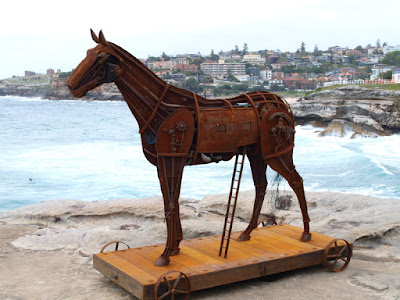Botany by the Sea

My francophile wife, Lynda, notices every French accent and conversation as we pass by thousands of people shuffling along the cliff tops of Bondi. Me? Well I see a plant motif in nearly every sculpture. Or if not a plant, some incongruous object that will grace a future presentation I give - for example, this first image will become a 'sea horse' in some context.
During my PhD study on algae that produced spores on the top of long straight branches, I used to drive along the Melbourne freeways at night identifying the street lights as one of the algal species, depending on how tall the poles were and how many light fittings they had. Yes one can get obsessed! Still, it's fun and adds a little something extra to life.
During my PhD study on algae that produced spores on the top of long straight branches, I used to drive along the Melbourne freeways at night identifying the street lights as one of the algal species, depending on how tall the poles were and how many light fittings they had. Yes one can get obsessed! Still, it's fun and adds a little something extra to life.
But back to Bondi and Sculpture by the Sea, and a few examples from our walk. This next one is obviously a cocolithophorid, a kind of alga covered in ornate umbrellas made of calcium. As it happens the sculpture is modelled on particular species of cocolithophorid, Calcidiscus leptoporus. The real thing is a few micrometres in diameter and floats around in the sea.
OK, this one is just a watch. But borrowing from Richard Dawkins and his 'Blind Watchmaker', I'm sure I can find a way to use this in a talk on evoluiton.


Mushrooms, or are they toadstools? In any case, they are more closely related to you and me than to the plants in our botanic garden. Still, we like to include them in our botanical family, just as we do the algae...
I'm sure this will illustrate some conundrum or knotty problem.
I'm always told we need more directional signage in the botanic gardens. Maybe this one will help?
And of course if this was in one of our botanic gardens we'd cover up this chap with a Ficus leaf.






Comments